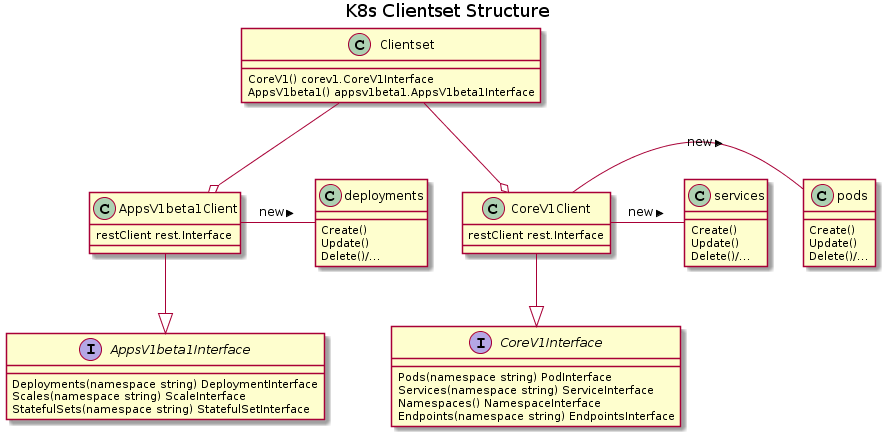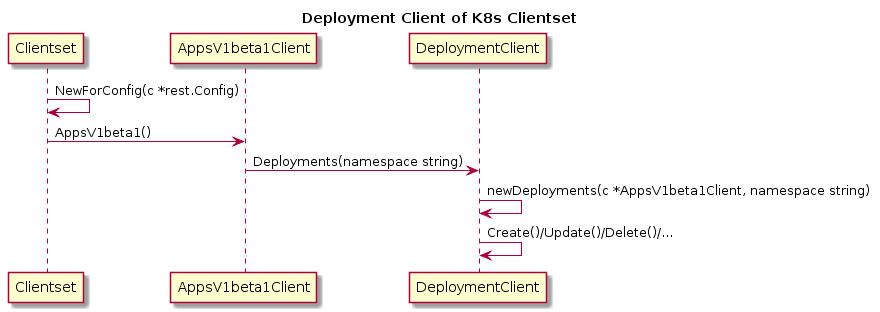The version of Kubernetes Client-go source code is
release-4.0.
2015年8月使用Go语言搭建基于Kubernetes的PaaS平台的时候,还没有任何Kubernetes的Go client。 只能把Kubernetes的核心源码撸一遍,通过源码级别集成Kubernetes,直接调用Kubernetes的一些代码,来实现Kubernetes资源的增删改查,以及watch等操作。这种实现方式存在三个主要问题:
- 必须对Kubernetes的核心源码非常熟悉;
- 直接依赖Kubernetes源码,导致Kubernetes大版本升级的时候,可能需要更新依赖的Kubernetes源码;
- 自己需要实现的代码量比较大。
最近基于Kubernetes官方提供的Go client Client-go又开发了一次PaaS平台,发现Client-go已经将Kubernetes的各种操作封装地很好,使用起来非常方便和清晰。因此,基本上一个星期的时间,就把Kubernetes相关的绝大部分功能都实现了。
Kubernetes官方从2016年8月份开始,将Kubernetes资源操作相关的核心源码抽取出来,独立出来一个项目Client-go,作为官方提供的Go client。Kubernetes的部分代码也是基于这个client实现的,所以对这个client的质量、性能等方面还是非常有信心的。目前,Kubernetes官方提供clients只有Go client和Python Client,而且他们已经还在Kubernetes Clients中开始尝试提供Java、Javascript等语言的clients,不过这些语言的clients还在不断完善中。像Java的Kubernetes client,官方的建议还是fabric8io/kubernetes-client。
Kubernetes Clientset
众所周知,Kubernetes的API是非常庞大而且复杂的。庞大体现在操作的Resources种类非常多,例如:namespace、service、pod、node、deployment、daemonset、ingress、configmap等;复杂体现在API成熟的程度,例如:v1、v1beta1、v1alpha1等。为了方便对这些API进行有效管理,将它们根据功能进行分组:core组包括一些最核心的resource的操作,例如namespace、service、pod、node等;extensions组包括一些扩展的resource的操作,例如daemonset、deployment、replicaset、ingress等;rbac组包括一些权限控制相关的resource的操作,例如role、clusterrole等。
Kubernetes clientset就是这些组的client的集合,集合中的每个client只能操作相应的group中的resource,其他group中的resource是无法进行操作的。
type Interface interface {
Discovery() discovery.DiscoveryInterface
AdmissionregistrationV1alpha1() admissionregistrationv1alpha1.AdmissionregistrationV1alpha1Interface
// Deprecated: please explicitly pick a version if possible.
Admissionregistration() admissionregistrationv1alpha1.AdmissionregistrationV1alpha1Interface
CoreV1() corev1.CoreV1Interface
// Deprecated: please explicitly pick a version if possible.
Core() corev1.CoreV1Interface
AppsV1beta1() appsv1beta1.AppsV1beta1Interface
// Deprecated: please explicitly pick a version if possible.
Apps() appsv1beta1.AppsV1beta1Interface
AuthenticationV1() authenticationv1.AuthenticationV1Interface
// Deprecated: please explicitly pick a version if possible.
Authentication() authenticationv1.AuthenticationV1Interface
AuthenticationV1beta1() authenticationv1beta1.AuthenticationV1beta1Interface
AuthorizationV1() authorizationv1.AuthorizationV1Interface
// Deprecated: please explicitly pick a version if possible.
Authorization() authorizationv1.AuthorizationV1Interface
AuthorizationV1beta1() authorizationv1beta1.AuthorizationV1beta1Interface
AutoscalingV1() autoscalingv1.AutoscalingV1Interface
// Deprecated: please explicitly pick a version if possible.
Autoscaling() autoscalingv1.AutoscalingV1Interface
AutoscalingV2alpha1() autoscalingv2alpha1.AutoscalingV2alpha1Interface
BatchV1() batchv1.BatchV1Interface
// Deprecated: please explicitly pick a version if possible.
Batch() batchv1.BatchV1Interface
BatchV2alpha1() batchv2alpha1.BatchV2alpha1Interface
CertificatesV1beta1() certificatesv1beta1.CertificatesV1beta1Interface
// Deprecated: please explicitly pick a version if possible.
Certificates() certificatesv1beta1.CertificatesV1beta1Interface
ExtensionsV1beta1() extensionsv1beta1.ExtensionsV1beta1Interface
// Deprecated: please explicitly pick a version if possible.
Extensions() extensionsv1beta1.ExtensionsV1beta1Interface
NetworkingV1() networkingv1.NetworkingV1Interface
// Deprecated: please explicitly pick a version if possible.
Networking() networkingv1.NetworkingV1Interface
PolicyV1beta1() policyv1beta1.PolicyV1beta1Interface
// Deprecated: please explicitly pick a version if possible.
Policy() policyv1beta1.PolicyV1beta1Interface
RbacV1beta1() rbacv1beta1.RbacV1beta1Interface
// Deprecated: please explicitly pick a version if possible.
Rbac() rbacv1beta1.RbacV1beta1Interface
RbacV1alpha1() rbacv1alpha1.RbacV1alpha1Interface
SettingsV1alpha1() settingsv1alpha1.SettingsV1alpha1Interface
// Deprecated: please explicitly pick a version if possible.
Settings() settingsv1alpha1.SettingsV1alpha1Interface
StorageV1beta1() storagev1beta1.StorageV1beta1Interface
StorageV1() storagev1.StorageV1Interface
// Deprecated: please explicitly pick a version if possible.
Storage() storagev1.StorageV1Interface
}
// Clientset contains the clients for groups. Each group has exactly one
// version included in a Clientset.
type Clientset struct {
*discovery.DiscoveryClient
*admissionregistrationv1alpha1.AdmissionregistrationV1alpha1Client
*corev1.CoreV1Client
*appsv1beta1.AppsV1beta1Client
*authenticationv1.AuthenticationV1Client
*authenticationv1beta1.AuthenticationV1beta1Client
*authorizationv1.AuthorizationV1Client
*authorizationv1beta1.AuthorizationV1beta1Client
*autoscalingv1.AutoscalingV1Client
*autoscalingv2alpha1.AutoscalingV2alpha1Client
*batchv1.BatchV1Client
*batchv2alpha1.BatchV2alpha1Client
*certificatesv1beta1.CertificatesV1beta1Client
*extensionsv1beta1.ExtensionsV1beta1Client
*networkingv1.NetworkingV1Client
*policyv1beta1.PolicyV1beta1Client
*rbacv1beta1.RbacV1beta1Client
*rbacv1alpha1.RbacV1alpha1Client
*settingsv1alpha1.SettingsV1alpha1Client
*storagev1beta1.StorageV1beta1Client
*storagev1.StorageV1Client
}
整个Clientset的数据结构图如下:

Deployment Example
下面通过官方提供的deployment example,来介绍如何使用Client go来实现deployment的增删改查,展示其实现起来是多么简单:
- 通过kubeconfig创建clientset
- 通过clientset创建deployment client
- 通过deployment client执行deployment的增删改查
由Clientset操作deployment的流程图如下:

// AppsV1beta1 retrieves the AppsV1beta1Client
func (c *Clientset) AppsV1beta1() appsv1beta1.AppsV1beta1Interface {
if c == nil {
return nil
}
return c.AppsV1beta1Client
}
type AppsV1beta1Interface interface {
RESTClient() rest.Interface
ControllerRevisionsGetter
DeploymentsGetter
ScalesGetter
StatefulSetsGetter
}
// AppsV1beta1Client is used to interact with features provided by the apps group.
type AppsV1beta1Client struct {
restClient rest.Interface
}
func (c *AppsV1beta1Client) ControllerRevisions(namespace string) ControllerRevisionInterface {
return newControllerRevisions(c, namespace)
}
func (c *AppsV1beta1Client) Deployments(namespace string) DeploymentInterface {
return newDeployments(c, namespace)
}
kubernetes/typed/apps/v1beta1/deployment.go
// DeploymentsGetter has a method to return a DeploymentInterface.
// A group's client should implement this interface.
type DeploymentsGetter interface {
Deployments(namespace string) DeploymentInterface
}
// DeploymentInterface has methods to work with Deployment resources.
type DeploymentInterface interface {
Create(*v1beta1.Deployment) (*v1beta1.Deployment, error)
Update(*v1beta1.Deployment) (*v1beta1.Deployment, error)
UpdateStatus(*v1beta1.Deployment) (*v1beta1.Deployment, error)
Delete(name string, options *v1.DeleteOptions) error
DeleteCollection(options *v1.DeleteOptions, listOptions v1.ListOptions) error
Get(name string, options v1.GetOptions) (*v1beta1.Deployment, error)
List(opts v1.ListOptions) (*v1beta1.DeploymentList, error)
Watch(opts v1.ListOptions) (watch.Interface, error)
Patch(name string, pt types.PatchType, data []byte, subresources ...string) (result *v1beta1.Deployment, err error)
DeploymentExpansion
}
// deployments implements DeploymentInterface
type deployments struct {
client rest.Interface
ns string
}
// newDeployments returns a Deployments
func newDeployments(c *AppsV1beta1Client, namespace string) *deployments {
return &deployments{
client: c.RESTClient(),
ns: namespace,
}
}
// Create takes the representation of a deployment and creates it. Returns the server's representation of the deployment, and an error, if there is any.
func (c *deployments) Create(deployment *v1beta1.Deployment) (result *v1beta1.Deployment, err error) {
result = &v1beta1.Deployment{}
err = c.client.Post().
Namespace(c.ns).
Resource("deployments").
Body(deployment).
Do().
Into(result)
return
}
// Update takes the representation of a deployment and updates it. Returns the server's representation of the deployment, and an error, if there is any.
func (c *deployments) Update(deployment *v1beta1.Deployment) (result *v1beta1.Deployment, err error) {
result = &v1beta1.Deployment{}
err = c.client.Put().
Namespace(c.ns).
Resource("deployments").
Name(deployment.Name).
Body(deployment).
Do().
Into(result)
return
}
...
// Delete takes name of the deployment and deletes it. Returns an error if one occurs.
func (c *deployments) Delete(name string, options *v1.DeleteOptions) error {
return c.client.Delete().
Namespace(c.ns).
Resource("deployments").
Name(name).
Body(options).
Do().
Error()
}
...
Conclusions
目前官方提供的这个Clientset不是特别好用,主要因是获得具体的某个resource client的时候,必须绑定namespace,导致这个client不能访问跨namespace的resource。 每个resource client最核心的是rest client,对于不同的group,不同namespace以及不同resource,发送的rest请求不一样。
Kubernetes提供的Client go无论是操作不同namespace下的相同resource,还是相同namespace下的不同resource,都得new一个新的client。无法做到一个clientset能够操作所有namespace中的所有resources。这样会严重影响效率,而且会浪费内存资源。
在某些应用场景下,可能需要对不同namespace下的相同类型的resource进行频繁操作,这种实现方式就非常不灵活。 因此,在我们的PaaS平台没有直接使用原生的Client go,而是自己封装了一个clientset上,针对每类resource都有一个通用的client。该clientset直接提供操作所有类型的resources的接口,在调用操作具体resources接口的时候,通过参数指定namespace,从而实现一个clientset能够统一地操作所有namespace中的所有resources。具体实现,可以参考k8s-goclient。